Continuing the blog from my recent trip to Australia, courtesy of the South Australian and Tasmanian tourist boards.
17th October 2012
An off-the-cuff remark from Rob our boatman brought it home. We were lounging on the upper deck of our cruise launch MV Reflections, enjoying the sun and looking forward to lunch as we chugged gently down the Arthur River, when he glanced towards the forested hills and said: “No-one has ever set foot on some of that ground”. It was a jolting reminder of the nature of north-west Tasmania. The temperate rainforest of this Tarkan region is indeed quite a wilderness, and it’s easy to believe that secrets still lurk within it. After all, this is where explorers even today come looking for the Thylacine, the “Tasmanian Tiger” extinct since the 1930s. As with other famous “lost” wildlife there are regular reports of living animals, yet never any proof. Perhaps the most credible, though, was by an experienced ranger in 1982, here at this very place, Arthur River.
Today, though, the zoology is not cryptic, but somewhat in your face. These waterways are a great site for the White-bellied Sea Eagle, and Rob the boatman has developed the trick of
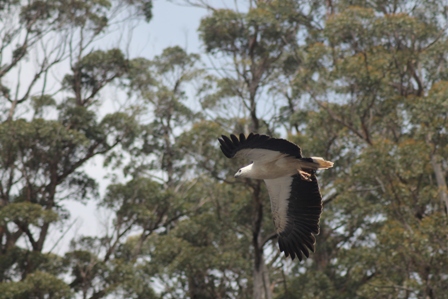
White-bellied Sea Eagle, Arthur River, Tasmania, 17/10/12 (Dominic Couzens)
throwing fish slices out of the side of the MV Reflections for the eagles to snatch from the water surface. It makes for a spectacular sight, albeit one that you need to be on your toes to photograph, pushing the camera’s autofocus to the limit. The White-bellied Sea Eagle is closely related to our own White-tailed version, and is similarly catholic in its diet, taking a lot of birds, both adults and young, as well as fish. Members of
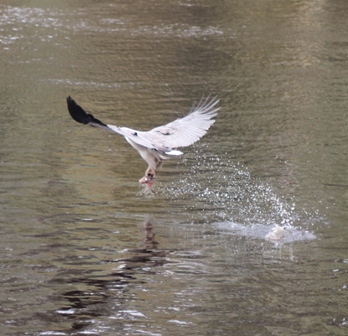
White-bellied Sea Eagle, Arthur River, Tasmania, 17/10/12 (Dominic Couzens)
a pair, which remain together for life, often work together to procure prey, one flushing prey out, the other snatching the fleeing animals. Today, though, the Sea Eagles didn’t have everything their own way. A Wedge-tailed Eagle was also in the vicinity, and the two species seem to have a fractious relationship. Indeed, while we were watching, a Wedge-tail and a Sea Eagle actually flew aggressively at each other – a pretty impressive spectacle.
While on our cruise we stopped for lunch at a small jetty, where Rob had made his very own nature trail for a short way into the bush. This trail turned out to be absolutely superb for birds. Not only was a Black Currawong hanging out by the picnic site, but we also managed to get good views of
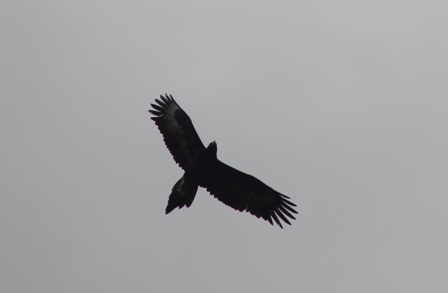
Wedge-tailed Eagle, Arthur River, Tasmania, 17/10/12 (Dominic Couzens)
Tasmanian Thornbill, Tasmanian Scrubwren, Scrubtit and the gorgeous Pink Robin.The latter species was new to us, and what a stunner it is: the colour is like no other bird that I can think of. In the photo below, you can at least get an idea of what this little gem actually looks like.
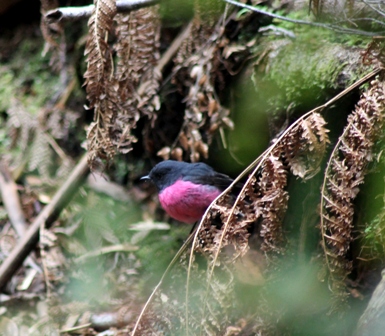
Pink Robin, Arthur River, Tasmania, 17/10/12 (Dominic Couzens)
Meanwhile, Black Currawong and Scrubtit are Tasmanian endemics, while the Pink Robin has dual
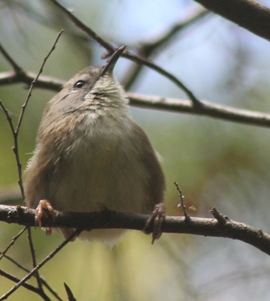
Scrubtit, Arthur River, Tasmania, 17/10/12 (Dominic Couzens)
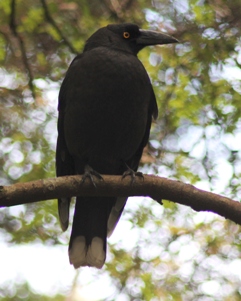
- Black Currawong, Arthur River, Tasmania, 17/10/12 (Dominic Couzens)
nationality, so to speak. It is commonest on Tasmania, but a separate race occurs locally on the mainland, and is a winter visitor as far north as southern New South Wales.
As for the afternoon, we all jumped at the chance to repeat our visit to King’s Run to see some more Tasmanian Devils. Tonia had sensibly arranged to have two attempts at these animals, just in case we missed them the first time. On this occasion at least five individuals turned up, including a large male, which dwarfed the rest. At one point three Devils showed all at once, with obvious tensions between them – an exciting end to our visit to this part of Tasmania.
